Here are some of the gruesome details that get left out in the modern versions of 10 classic fairy tales.
1. Cinderella’s evil stepsisters have their eyes pecked out by birds.
One of the most well-known early versions of “Cinderella” was recorded by the Brothers Grimm. The most surprising difference between this story and modern versions of Cinderella was the way it ended. The Disney movie ends with Cinderella and the prince getting married, riding off in a carriage, and the now-famous words “and they lived happily ever after” appearing on screen. In the Brothers Grimm version, the story ends by focusing on Cinderella’s evil stepsisters getting their just deserts. During Cinderella’s wedding, doves peck out her stepsisters’ eyes, and the story concludes by noting they had to endure blindness for the rest of their lives. Another gruesome detail left out of modern versions of the story is that the stepsisters cut off their toes and heels in an attempt to fit into Cinderella’s slipper and fool the prince.(source)
2. The three bears brutally kill Goldilocks.
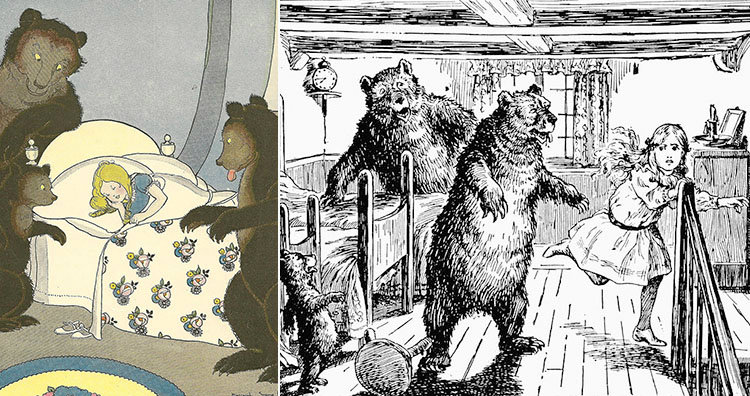
Today, the fairy tale of “Goldilocks and the Three Bears” is all about finding something that’s “just right,” but early versions of the story had a moral. The story was meant to teach a lesson about the hazards of exploring unknown territory and using the possessions of others. Originally, the main character was an old woman who was ugly, dirty, foul-mouthed, and inconsiderate. In one early version, when the bears get home, she tries to run away and breaks her neck. In another version, the bears throw her on top of a cathedral and she gets impaled on the steeple.(source)
3. The wolf fools Little Red Riding Hood into eating her grandmother and then tells her to get naked before coming to bed.
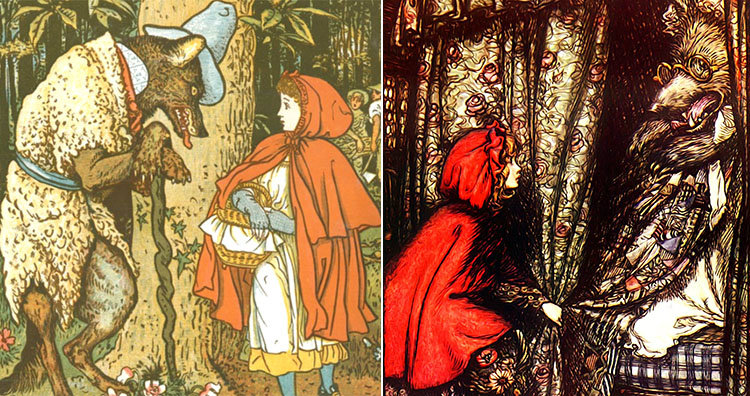
In some early versions of the fairy tale “Little Red Riding Hood,” there was no huntsman to come to the rescue and no happy ending. Little Red Riding Hood was simply fooled by the wolf posing as her grandmother and ends up getting eaten.
Early versions also had some sexual connotations as the wolf asked her to remove her clothes and throw them in the fire before getting in the bed. In many early versions, the wolf also fools the girl into cannibalizing her grandmother as the wolf had saved some of the meat and blood for the girl to consume.
The earliest known printed version was recorded by Charles Perrault in 1697. This version ended with an explanation of the moral. It said that children, especially young and pretty girls, should not listen to strangers. It also warned girls to be aware that the most dangerous “wolves” often disguise themselves as gentlemen until they get what they want.(source)
4. A king rapes Sleeping Beauty while she’s asleep.
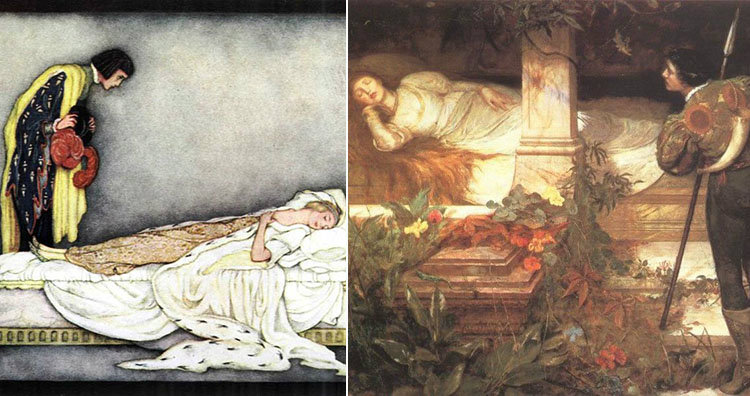
One of the earliest versions of the fairy tale “Sleeping Beauty” was published in 1634 by Italian poet Giambattista Basile, and it was based on a number of folk tales. One major difference from modern versions is how the sleeping princess is awoken. In Basile’s version, a king discovers the sleeping princess and has sex with her. The princess gets pregnant and gives birth to twins while still unconscious. She finally wakes up when one of the twins is sucking on her finger and sucks out the splinter that had caused her deep sleep.
Another difference from modern versions is that the king in this story is already married. When the king’s wife learns about the twins, she tells a cook to murder them, cook them, and serve them to the king. The cook fools the king’s wife by serving two lambs instead. Then the king finds out about his wife’s plan and orders that she be burned to death. He also rewards the cook for saving his children. The newly-single king is then free to marry the princess and live happily ever after.(source)
5. The Evil Queen gets tortured to death at Snow White’s wedding. She’s forced to wear red-hot iron shoes and dance until she dies.

In modern versions of “Snow White,” the villain is Snow White’s evil stepmother. But in the version published in 1812 by the Brothers Grimm, the Evil Queen is actually Snow White’s birth mother. Similar to modern versions, the queen gets jealous that Snow White is more beautiful than her, and repeatedly tries to kill her.
The most shocking difference is how the queen dies. In the Disney movie, the queen dies when she’s standing on a cliff and a lightning strike makes her fall to her death. But in the Brothers Grimm version, the Evil Queen gets invited to Snow White’s wedding. When the queen shows up, she’s shocked to see that Snow White is still alive. As the queen stands frozen out of rage and fear, Snow White gets some gruesome revenge.
“Iron slippers had already been put upon the fire, and they were brought in with tongs and set before her. Then she was forced to put on the red-hot shoes and dance until she dropped down dead.”(1,2)
6. Pinocchio gets Geppetto sent to prison and then kills the talking cricket. The story ends with a detailed description of Pinocchio’s death by hanging.
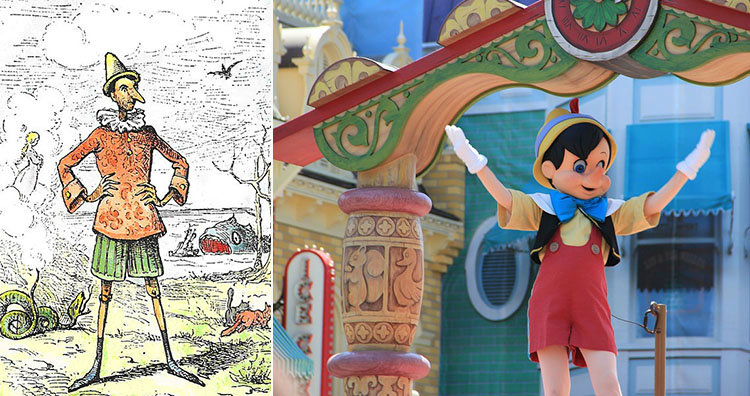
The Disney film version Pinocchio had some dark themes, such as the part where naughty boys are turned into donkeys and sold into slave labor. But that’s nothing compared to the original story published in 1883 as the novel The Adventures of Pinocchio. That story was meant to serve as a warning against bad behavior, and so Pinocchio was depicted as an evil character with no redeeming qualities. For instance, Pinocchio starts kicking Geppetto as soon as the carpenter has finished carving his feet. Once he’s fully built, he laughs in his creator’s face, steals his wig, and runs away. The police then find Pinocchio and assume he was being mistreated, so they put Geppetto in prison. Pinocchio then returns home and kills the talking cricket that has lived there for over a hundred years.
Eventually, Pinocchio gets what’s coming to him as his enemies hang him from a tree. His death is described in vivid detail.
“Wind began to blow and roar angrily, and it beat the poor puppet from side to side, making him swing violently, like the clatter of a bell ringing for a wedding. And the swinging gave him atrocious spasms. His breath failed him and he could say no more. He shut his eyes, opened his mouth, stretched his legs, gave a long shudder, and hung stiff and insensible.”(1,2,3)
7. The Little Mermaid wanted to become human so she could have a soul. When it didn’t work out, she planned on killing the prince so she could go back to being a mermaid.
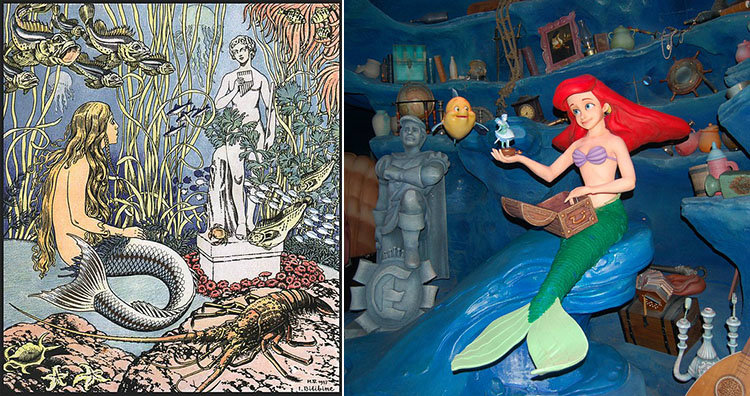
“The Little Mermaid” was published by Hans Christian Andersen in 1837. In the original story, the Little Mermaid learns that mermaids don’t have souls and dissolve into sea foam when they die while humans live on forever in the afterlife. So she decides she wants to become human.
In order to obtain a soul, she has to win the love of the prince and marry him. That way, part of the prince’s soul will flow into her. Her grandmother warns her if the prince marries someone else, she’ll die and turn into sea foam on the day after the wedding. When the Little Mermaid and the prince meet, he is mesmerized by her beauty and loves watching her dance. That last part is unfortunate because the mermaid’s human legs give her excruciating pain with every step, making it feel like she’s walking on sharp knives.
In the end, the prince decides to marry someone else. The Little Mermaid then has a chance to become a mermaid again by killing the prince with a sea witch’s knife and letting his blood drip on her feet. She’s about to kill the prince as he sleeps next to his new bride, but at last minute, she decides not to go through with it. So she dies and turns into sea foam. In the original version, the story ends there.
But the author later revised the story and added a happy ending. After the Little Mermaid dissolves, she becomes a spirit. She learns that because of her selflessness, she’s been given a chance to earn an immortal soul for herself. To do that, she has to perform good deeds for mankind for 300 years.(source)
8. “The Frog Prince” was about a young woman overcoming her fear of male genitalia.
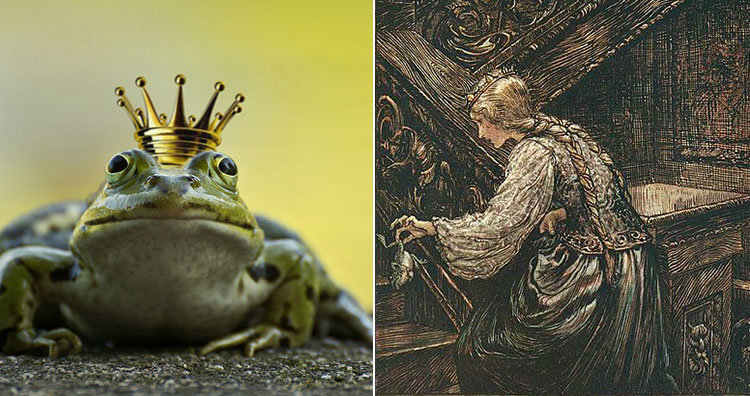
In most versions of this fairy tale, a princess accidentally drops a golden ball in a pond, and a frog offers to retrieve it in exchange for a kiss. When the princess kisses the frog, it magically transforms into a handsome prince and they get married. The moral of the story seems to be that if you keep your promises, good things happen. But some scholars say the story is really about a young girl maturing and getting over her fear of male genitalia. They say the frog is a symbol of a penis, and in early versions of the story, the princess promised to sleep with him. But she finds the frog so disgusting that it’s difficult for her. Once she gets over her disgust, she lives up to her promise and accepts him in her bed. Then she’s rewarded with a husband.(1,2)
9. In the novel The Fox and the Hound, after the hound finally kills the fox, his owner decides to move to a nursing home where dogs aren’t allowed, so he shoots the hound.

This story is based on a novel published in 1967. In the Disney movie version, it’s a story about friendship. Copper the hound dog becomes friends with Tod the fox and prevents his master from shooting him, and everyone lives happily ever after. But things didn’t go so well in the novel. Instead, the fox lures one of the hunting dogs onto train tracks so it gets killed by the train. Copper and his master spend years hunting the fox to get revenge. Eventually, Tod dies from exhaustion after being relentlessly chased by Copper. By this point in the novel, Copper’s master is a run-down alcoholic who’s preparing to move into a nursing home where dogs aren’t allowed. So he takes Copper outside and shoots him with a shotgun.(1,2)
10. Peter Pan murdered some of the Lost Boys when they started growing old.
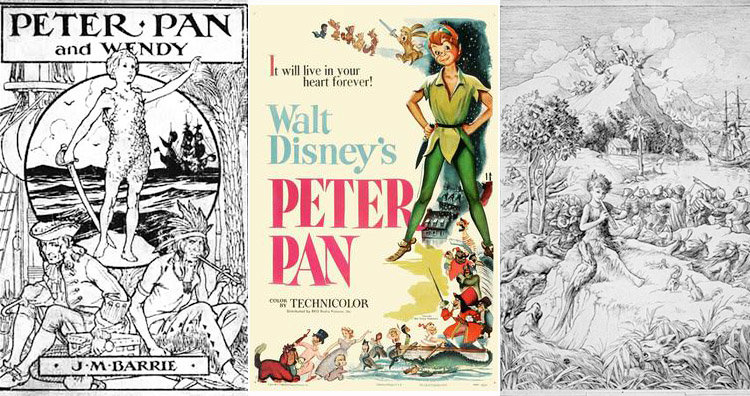
Peter Pan was originally a play that premiered in 1904, and the playwright also turned the story into a novel that was released in 1911. In that version of the story, it’s implied that Peter would sometimes kill the Lost Boys if they grew too old. In the novel, staying in Neverland only slowed down the aging process, it didn’t completely stop it.
“The boys on the island vary, of course, in numbers as they get killed and so on; and when they seem to be growing up, which is against the rules, Peter thins them out.”
The story also vaguely implies that Peter would disfigure the Lost Boys to get them to fit into their hideouts inside hollow trees.
“You simply must fit…but if you are bumpy in awkward places or the only available tree is an odd shape, Peter does some things to you, and after that, you fit.”
But this didn’t mean that Peter Pan was evil. Instead, he was depicted as an innocent character that couldn’t understand the consequences of his actions. In order to stay childlike, Peter Pan had to always live in the moment. He would do whatever occurred to him at the time and forget about it immediately afterward. In this way, the story showed how it’s important to eventually grow up. (1,2)








No comments:
Post a Comment